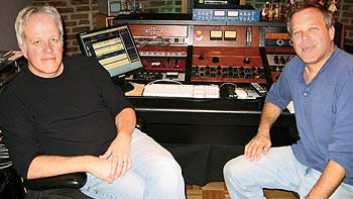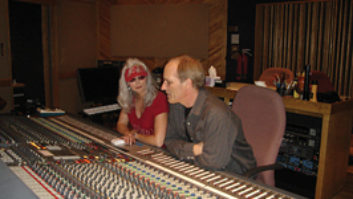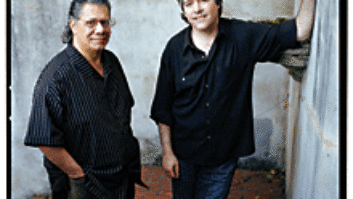Remember those old family driving vacations — mom and dad in the front seat, you and your brother or sister in the back, stopping every few hours along the scenic byways to see the sights? Now, imagine recording an album that way; the making of Earl Scruggs and Friends was a lot like that. Granted, the players traveled at 30,000 feet and not in a wood-paneled station wagon, but the premise was the same: Earl Scruggs; his wife and manager, Louise; son Randy Scruggs — an award-winning guitarist, songwriter and producer; and Ron “Snake” Reynolds, who recorded and mixed the album, packed up and traveled from city to city, studio to studio, to record the CD’s 12 tracks, which feature a variety of guests performing with the legendary banjo player.
With a career spanning more than 50 years, Scruggs has received 11 Grammy nominations, recorded countless albums and is credited with bringing bluegrass music to international notoriety. Born in North Carolina, he began playing banjo at age 4 and, as a 10-year-old, developed the three-finger style known as “Scruggs-style picking.” With Lester Flatt, his musical partner for more than two decades (beginning when they were members of Bill Monroe’s Bluegrass Boys), Scruggs had the first Number One bluegrass single, 1962’s “The Ballad of Jed Clampett,” also known as the theme song to The Beverly Hillbillies. In 1969, the duo parted ways, and Flatt died in 1979.
Scruggs’ sound diversified as his solo career gathered steam; today, at 77, he continues to record, perform and awe generations of music fans in every genre. Not only is Scruggs a musical legend, but so is his banjo: a Gibson Granada model manufactured in 1934 that he acquired in 1949. The banjo — and the extraordinary talent of the man playing it — is the tie that binds Earl Scruggs and Friends, the defining thread running through the album’s collection of styles. And, quips Ron Reynolds of the rare instrument, “If he makes enough money off of this album, he might be able to buy a new one!”
Joining Scruggs on this unique project are Elton John, Sting, Melissa Etheridge, John Fogerty, Johnny Cash, Don Henley, Vince Gill, Dwight Yoakam, Marty Stuart, Billy Bob Thornton, Randy and Gary Scruggs, Travis Tritt and Rosanne Cash. They make Earl Scruggs and Friends a musical gumbo, from the all-out pickin’ fest of the instrumental all-star “Foggy Mountain Breakdown” to Yoakam’s hip, haunting sound on “Borrowed Love.” “Fill Her Up” is pure Sting — rhythmic and soulful — though banjo-enhanced. Surprisingly, it’s the Randy Scruggs original, “Somethin’ Just Ain’t Right,” that leans most toward a rock feel — further testament to Earl Scruggs’ broad musical tastes.
Reynolds calls the guest lineup, “The best of the best of artists and musicians. They didn’t participate in this album for money; they did it for love of music and because they respect and idolize Earl.” A perfect example is Elton John, whose “Country Comfort,” from his country-flavored Tumbleweed Connection album, was the first track recorded and opens the CD. Notes Randy Scruggs, “Elton is such a fan of dad’s — he came into the studio with a boxed set and asked dad to autograph it. The caliber of Elton’s artistry is so professional; he is the true essence of an artist. What better way to kick off the project?”
The planning stages of the album took just over two years, with a year passing from the first note recorded to the mastering. Mixing was mostly done at Scrugg’s Sound Studio in Nashville, except for Sting’s track, which was mixed at The Sound Kitchen in Nashville. Recording, however, was a different story. Yoakam’s song was recorded at Conway Studio, Track Record and Dog Bone Studio in Los Angeles; Elton John’s at Tree Sound Studio in Norcross, Ga.; Thornton’s at Ocean Way in Nashville; Gary Scruggs’ with Travis Tritt’s, John Fogerty’s and Marty Stuart’s at Scruggs Sound; Etheridge’s at Conway; Sting’s at Scruggs Sound and at Steerpike Studio in Wiltshire, England, where he finished his vocal; “Foggy Mountain Breakdown” at Scruggs Sound, Leon Russell Studio in Nashville, Conway in L.A., and Sear Sound in New York City; Gill and Rosanne Cash’s at Scruggs Sound and Sear; and Henley and Johnny Cash’s at Scruggs Sound, TM Century in Dallas (Henley), and Cinnamon Hill Recording in Montego Bay, Jamaica (Cash).
Exhausting as it is just to read the credits, let alone imagine all the packing and unpacking and logging of miles, Earl Scruggs denies any wear and tear, noting that, thanks to the ease of studio work today, “It was all so much fun to do. Every artist was exciting to work with and really fueled the flame. In the early days, we only used one mic stand and we would all stand around that one mic, then mix it ourselves. Now we have Snake behind the board to do all that work for us. And when Randy and Snake say it’s right, it suits me. It’s amazing how closely they listen. I never listen that close, and what’s easy for me is not having to worry about technical situations or corrections. They catch it.”
“The very first thing we did [in each studio] was, we wanted to make sure we had the best sound possible on dad’s banjo,” says Randy. “That’s the thread throughout this project, so it was a shootout thing with several mics and configurations and distances.”
“Earl has a banjo sound and style that is uniquely his,” says Reynolds, “and that’s what we tried to capture on this record. Earl and Louise and I would listen and compare notes. The consistent mic I used on each track was the Audio-Technica 4033 on Earl — it’s real warm-sounding. On Randy’s acoustic guitar, where available, I used two 4033s — one left-hand upper and one body; everything else floats with the studio, depending on what they have. On the fiddle, I used a tube mic for Glen Duncan; he’s on all the songs. I used a Neumann M-249 when available, or a Neumann Tube 47 or 67. The rest of the mics flowed around.
“For vocal mics, Melissa was an AKG C-12. Elton: a bunch of different vocal mics, because he has such a powerful voice. We had a Neumann U67 padded down. Don Henley was an Audio-Technica 4060, which he requested.
“Every studio had a different board,” Reynolds continues. “Randy has a Neve 8232. At Tree, it was an SSL 4064 with G Plus. Conway, a VR 72 series. Ocean Way, a Neve 8078. TM, a Euphonix console, just for Don’s voice. We mixed Sting at Sound Kitchen in their Neve room with a VR 60. Sear has a custom console that they built themselves. In Jamaica, we took over a Tascam DA-78 machine with a Mackie mixer and dbx 160 compressor for Johnny Cash’s vocal narration, to monitor the tracks, and we used an Audio-Technica 4033 mic on his vocal.
“Machine-wise, almost everything was recorded on a Mitsubishi X850 32-track. We used a Sony 3348 at Conway for Melissa and Dwight. Sting’s original track was cut on an X850 32-track at Randy’s studio and transferred to 48-track for him to record in his studio and do what he needed to do. Then he sent it back on 48-track, and we stayed on the 3348 and mixed it at Sound Kitchen on that format.”
“We used analog on Rosanne’s vocals,” Randy adds. “They were done at Sear and transferred to 24-track analog. And ‘Foggy Mountain Breakdown’ is on the Otari RADAR 2, a hard disk system, for editing and transfers.”
Says Reynolds, “Anything that exists, we used it.” With one exception: Pro Tools is de rigueur for most of today’s recordings, but on this project, we chose not to use Pro Tools tricks, so we could keep everything as live and real as possible,” Reynolds says. “We were looking to capture sounds, not create them, so most of what is on this album is first, second or third takes. The performances are live with very little overdubbing. I’m an old-school guy. I started in 1969 as a recording engineer in Nashville, and, fortunately, I grew up in the business and got in it at a time when the ‘Nashville Sound’ was a happening thing. I try not to let technology get in the way of music. Music is the most important thing, because without it, you’ve got nothing.”
Foremost in Randy’s mind was that the album not be merely a compilation or something spliced together where singing partners cut their tracks and send them in. “I wanted continuity,” he says, hence the need for travel. “It didn’t matter where we were,” says Earl Scruggs. “It felt the same in each location, because the main people were always there. We’d just go in, I’d play what I feel, and it seemed to work. Randy did the same thing, and it helped to stabilize the sessions a lot. It was a fun trip for me.”
“My role and duties as producer and artist — and a lot of times in production, I participate in playing on certain tracks and as a songwriter — were to create a special album for dad, who does not have musical boundaries,” explains Randy. “He does not fence himself in. He has a history of collaboration with players like Bob Dylan. At home, he’d have jam sessions with people like Linda Ronstadt and Neil Young. With a project like this, you set the stage but you don’t overplan. My experience with this type of project is that it creates a life of its own.” [Randy Scruggs also produced the Nitty Gritty Dirt Band’s second volume of Will the Circle Be Unbroken and the Red, Hot & Country benefit compilation for AIDS research.]
There’s a certain irony in the fact that artists such as Elton John, Etheridge, Fogerty and Henley turned in performances that are far more “country” than most of what is coming out of Music Row these days. This isn’t lost on the album’s creators, although making a country record was never the goal. “You can’t deny there’s a country feel to this,” says Randy Scruggs, “but neither the performers nor any of us approached the project as being any format. It’s music, bottom line. Melissa Etheridge — we literally gave her a standing ovation in the control room. She could have had 40 Les Pauls overdubbed at the same time or just a mandolin — it wouldn’t have mattered. She gave the performance that the song needed, a musical performance from her heart.”
With a wealth of recording experience to his name and a discography that is pages long, Earl Scruggs finds himself partial to this gem of a CD. “I listen to this album more than any other album I’ve participated in,” he says, “and it never seems to grow old, which is great. I’ve listened to it practically every evening since we recorded it. It’s fresh each time because of all the excitement I remember in the studio, starting off with Elton in Atlanta. Every track has some of that same excitement. Recording with all of these different people, each track hit a high peak every time we went into the studio.”






